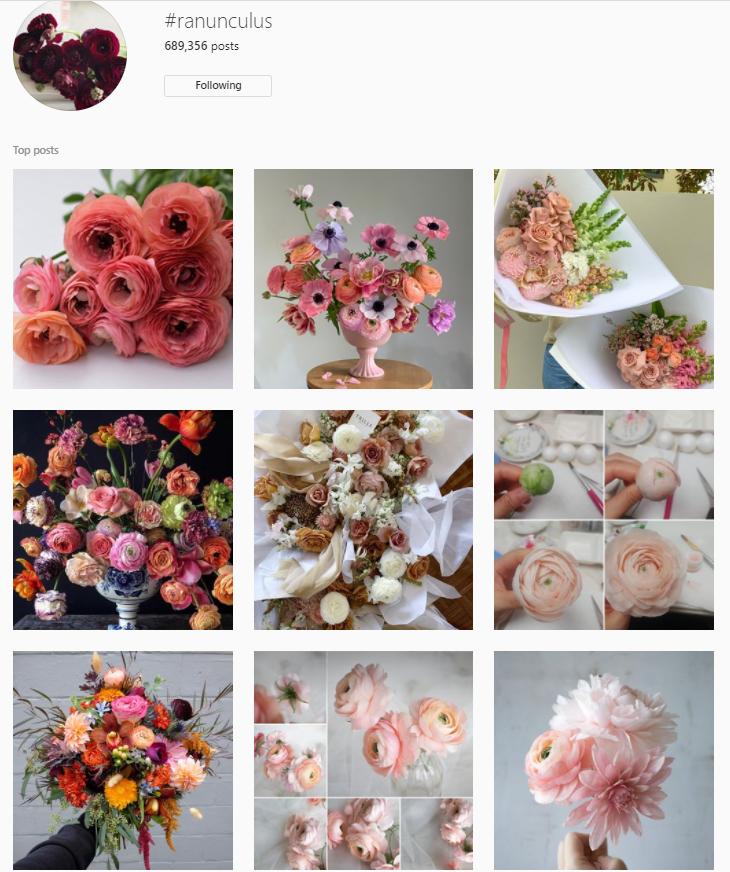Making a hash of hashtags (and what to do instead)
Hashtags are my least favourite part of my favourite social media channel, Instagram.
Following the #ranunculus hashtag on Instagram gives me so much joy!
For me Instagram is all about connecting with other people, being creative, sharing and being playful. Hashtagging feels boring, and like something that is used to game the system.
That said, following hashtags has really made me enjoy Instagram more as well - a few of my favourites are #dahlias, #ranunculus and #botanicaldaydreams, which make my feed beautifully floral. Following hashtags has also allowed me to discover new accounts which align with my interests, e.g. #ethicalmarketing.
Anyway, as much as I dislike hashtags, I acknowledge that in a business sense they are invaluable. Used cleverly, they can get you in front of new audiences and help you sell more.
Hashtags for a lockdown Christmas
As England goes into lockdown, people will be spending more time on their devices again, just as they did when we went into lockdown in the spring. But this time, they will be doing their Christmas shopping too.
For small businesses, that means they need to crank up their online marketing efforts (if you need help with this, check out my Merry Christmas Marketing course). As part of these improved efforts, you need to make sure your hashtags on Instagram are on point. Which is why you need to avoid these common pitfalls.
I keep seeing people make these top three hashtag mistakes on Instagram:
1. Your hashtags are too generic, e.g. #christmas which has been used nearly 146 million times, #lunch (88 million) or #cat (222 million). Yes, you can be too popular on Instagram (if you’re a hashtag!).
When you hit publish on a post that includes one of these hashtags, hundreds if not thousands of other people are doing the same thing at the same time. The result is that your post disappears in that noise and it doesn’t get found by anyone new (which is the purpose of a hashtag).
2. Your hashtags are too niche, e.g. #BestCakeInMarple, which has never been used, or #YourFriendlyNeighbourhoodShop, which has been used once. Hashtags like these may sound cute, but are too obscure - meaning nobody searches for it.
3. Not using all 30 hashtags for your posts. The opportunity is there, so why not use it?
How to hashtag
If you want people to find you via hashtags and you have fewer than 10k followers, I recommend sticking to hashtags that have been used between 1k and 100k times.
Take into consideration what your people are searching for, what your photo is about and what describes your business/is relevant to the industry in which you operate.
There are many people that share formulas for hashtagging success, and I suppose in some ways my advice in this blog is doing similar. The reality is that what works for one person will not work for the next. It really is a case of doing your own research (I do all my hashtag research on my laptop rather than in the app, purely because it is much easier!). And then it is about trying different things, experimenting and seeing what works.
Winter hashtags
After the lockdown announcement on the weekend, I tried to think of ways in which I can help those people on my Christmas course in a practical way over the coming weeks.
My solution was a document with over 100 Winter good hashtags covering Christmas and local shopping (for example, #shoplocal has been used 42 million times, so don't even bother with that one!). The document is a “live” one, meaning I plan to add more hashtags to it over the coming weeks as I come across more good ones.
The document is available for free for those people on the Christmas marketing course, but I have decided to also make it available as a download in my shop for £10.


